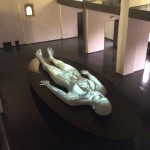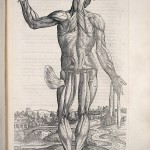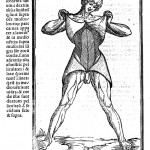By Helen King (Regular Contributor)
It’s still ‘Vesalius year’. The great anatomist was born in 1514, but so many places want to honor him on his 500th anniversary that conferences and exhibitions are still going on to the end of 2015. I’m just back from one in Padua and have also been to one in Leuven – it’s useful that he is linked to so many interesting cities in Europe!
But the enthusiasm for holding a Vesalius party is not restricted to those places where he trained or worked. When I was in Padua, we were told about the exciting plans for an exhibition later this year being put on by the Rare Books people at Duke University, who already have an excellent record for making medical history accessible with their exhibition on ‘Animated Anatomies’. In the USA alone, there are still over 60 copies of the first edition of Vesalius’ great work, De Humani Corporis Fabrica (1543), the vast majority of these in libraries rather than private collections. The stories about these copies are themselves amazing.
Here, for example, from Joffe and Buchanan’s recent census of the copies in the USA, is Dr W.G. MacCallum writing to the librarian at the New York Academy of Medicine in July 1939:
“In 1903 I was walking toward a bridge over the river in Rome & saw a blacksmith shop with the blacksmith in a shower of sparks hammering on the anvil – through the shower I saw a bench covered with old books. I went in and found the first edition of Vesalius’ Fabrica 1543 and bought it. On my return I gave my copy to Harvey Cushing as he was so greatly interested in Vesalius. Sometime afterward Dr. O. [William Osler], who had three, I believe, gave one to Barker as a wedding present, one to Cushing and took mine and sent it to McGill. From there it was sent to your library”.
Both Padua and Leuven are going beyond books in their representations of Vesalius. In the Leuven Museum M the description of ‘Vesalius. Imagining the Body’ warns: “Be amazed by the ‘living’ dead who candidly reveal what is concealed under their skin”. This is a reference to an extraordinary piece in which a video projection from four projectors is made on to a life-size model of a naked man. It is very disturbing because the projection gives the impression that this is a man who is alive, moving and breathing – until he raises his right hand and starts to draw a line on his chest which then extends to other parts of his body which apparently open up so that he ‘dissects himself’,until his flesh falls off to reveal his bones. In Museum M, this was shown in a reconstructed sixteenth-century anatomy theater. A few years before it was shown in an actual (although more recent) anatomy theater in the city. There’s a film of this – Vesalius Revisited – available. Those of a nervous disposition may be reassured by the fact that at the end of the ‘dissection’, the process is reversed.
 The video artist here is the Leuven-based Filip Sterckx. His self-flaying man is a clear reference to early modern images, whether these are the highly accomplished full-body figures in Vesalius or the cruder, rather cheerful figures who helpfully open up their abdomens for us.
The video artist here is the Leuven-based Filip Sterckx. His self-flaying man is a clear reference to early modern images, whether these are the highly accomplished full-body figures in Vesalius or the cruder, rather cheerful figures who helpfully open up their abdomens for us.
In Padua, at MuSME, they have a far more than life-size version of Sterckx’s installation. When we were there, before the official opening of this new museum, the projections on to the body were not of a dissection in progress, but of a range of historical images of the body, including some taken from Vesalius.
But the best news of all is that you don’t need to travel to see the work of Vesalius. The Turning the Pages project at the National Library of Medicine provides a selection of illustrated pages from this amazing book. Celebrate the anniversary by having a look!


